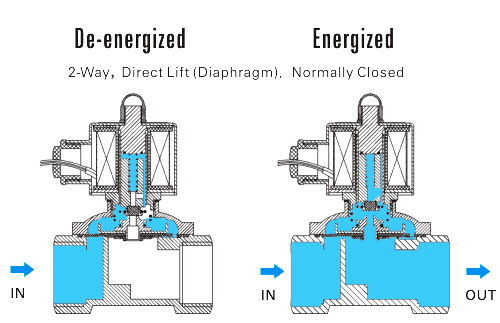Most solenoid valves
operate on a digital principle. They therefore
possess two distinct
states, which are (1) - when the coil is
activated by an
electrical current, and (2) - when the valve is resting
(without
electricity). Valve functions are defined from the resting
position.
The direct acting or
pilot operated solenoid valves may have two
Normally closed (NC)
A solenoid valve is
normally closed (abbreviated - NC) if there is no
flow across the valve
in its resting position (with no current on the
solenoid contacts).
Symbol
Please note that in
the case of 3-way solenoid valves, port A is
open to port R which,
for example, enables the valve’s single-action
cylinder to be
exhausted to atmosphere.
Normally open (NO)
A solenoid valve is
said to be“normally open” (abbreviated NO)
when it enables fluid
to pass in its resting position (with no current
on the solenoid
contacts).
Symbol
A specific choice of
entry ports can change a valve’s function.
However, since
balanced-force calculations take rebound effects,
coil effects and the
effects of pressure exerted on the seal into
account, the
performance of an NC valve fitted in an NO position
would be reduced. In
this configuration it would be better to choose
a universal solenoid
valve.
Latching or Bi-stable
applications a short
electrical impulse enables the solenoid valve
to be opened or
closed, and thanks to the residual effects of a
permanent magnet this
is sufficient for maintaining the valve in a
particular working
position with no electrical energy
consumption.
A short impulse of
inverted polarity ensures the valve’s return to its
previous position.
Electrical power consumption and heating are
almost negligible.

No comments:
Post a Comment